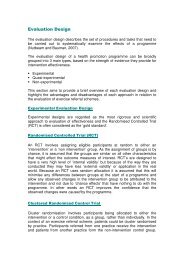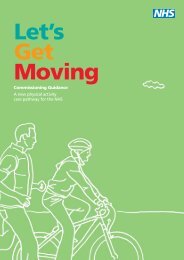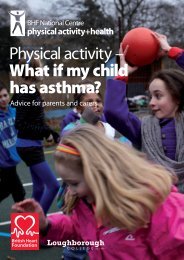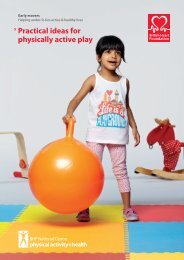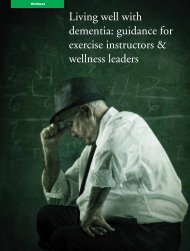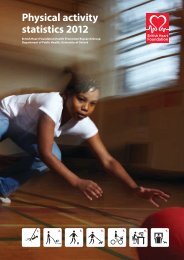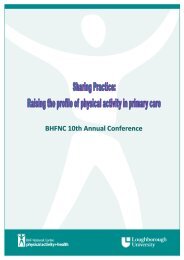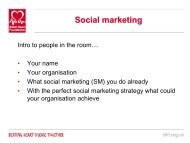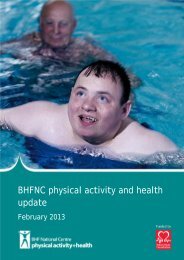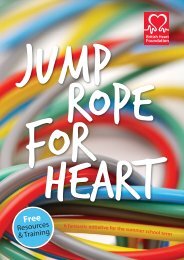Interpreting the UK physical activity guidelines for children and ...
Interpreting the UK physical activity guidelines for children and ...
Interpreting the UK physical activity guidelines for children and ...
You also want an ePaper? Increase the reach of your titles
YUMPU automatically turns print PDFs into web optimized ePapers that Google loves.
18<br />
<strong>Interpreting</strong> <strong>the</strong> <strong>UK</strong> <strong>physical</strong> <strong>activity</strong> <strong>guidelines</strong> <strong>for</strong> <strong>children</strong> <strong>and</strong> young people (5-18)<br />
Promoting <strong>physical</strong> <strong>activity</strong> to<br />
<strong>children</strong> <strong>and</strong> young people <strong>and</strong><br />
<strong>the</strong>ir parents/carers<br />
The <strong>physical</strong> <strong>activity</strong> <strong>guidelines</strong> are aimed at<br />
professionals <strong>and</strong> are not appropriate to use<br />
directly with <strong>the</strong> public. The <strong>guidelines</strong> need to be<br />
translated into clear <strong>and</strong> simple advice that highlights<br />
key messages. Consistency in messages from all<br />
professionals is important <strong>for</strong> maximum impact.<br />
Research commissioned by NHS Health Scotl<strong>and</strong> in<br />
2012 identifies recommendations on translating <strong>and</strong><br />
promoting <strong>the</strong> <strong>children</strong> <strong>and</strong> young people <strong>physical</strong><br />
<strong>activity</strong> <strong>guidelines</strong> to <strong>the</strong> public. Some of <strong>the</strong> key<br />
recommendations are summarised below.<br />
Use appropriate language <strong>for</strong> messages<br />
• Make sure in<strong>for</strong>mation <strong>and</strong> messages are relevant<br />
to <strong>children</strong> <strong>and</strong> young people, adaptations will be<br />
needed to cater <strong>for</strong> <strong>the</strong> wide age range.<br />
• The tone of messages <strong>and</strong> in<strong>for</strong>mation should<br />
be warm <strong>and</strong> friendly, using in<strong>for</strong>mal, everyday<br />
language, not patronising or lecturing.<br />
• Use language that is motivating <strong>for</strong> <strong>children</strong><br />
<strong>and</strong> young people – include words such as ‘fun’,<br />
‘friendship’ <strong>and</strong> ‘variety’.<br />
• Keep messages <strong>and</strong> advice simple, use everyday<br />
language that is easily understood, eg, ra<strong>the</strong>r than<br />
talking about ‘moderate intensity’ consider using<br />
‘medium ef<strong>for</strong>t’, use ‘healthy heart’ instead of<br />
‘cardiovascular health’ <strong>and</strong> ‘sitting’ instead of<br />
‘sedentary’.<br />
• Think about <strong>the</strong> best ways to convey <strong>the</strong><br />
in<strong>for</strong>mation – use appropriate language <strong>and</strong> a<br />
medium that is most likely to reach <strong>children</strong><br />
<strong>and</strong> young people (this is likely to vary according<br />
to age).<br />
‘Sell’ <strong>physical</strong> <strong>activity</strong> to <strong>children</strong> <strong>and</strong><br />
young people<br />
• Encouraging less active people to do more <strong>physical</strong><br />
<strong>activity</strong> will be most effective on a one-to-one<br />
basis, however, this is not always practical. If you<br />
are using population level messaging encourage<br />
<strong>children</strong> <strong>and</strong> young people to find that personal<br />
connection with <strong>physical</strong> <strong>activity</strong>.<br />
• Highlight benefits that are relevant to <strong>and</strong> valued<br />
by <strong>children</strong> <strong>and</strong> young people as <strong>the</strong>se are more<br />
likely to ‘hook’ <strong>the</strong>m in, eg, improving social skills,<br />
developing friendships, developing self-confidence<br />
<strong>and</strong> maintaining a healthy weight.<br />
• Highlight how <strong>physical</strong> <strong>activity</strong> can fit into <strong>the</strong>ir<br />
lifestyle, eg, walking or cycling to school, a kick<br />
around with friends in <strong>the</strong> park, being active at a<br />
youth club, joining a sport or <strong>activity</strong> club.<br />
• Offer <strong>physical</strong> <strong>activity</strong> which provides <strong>the</strong><br />
opportunity of achieving some o<strong>the</strong>r goal,<br />
eg, fundraising events, mass participation events,<br />
school projects. Consider messages that use<br />
<strong>the</strong>se ‘hooks’ to motivate <strong>children</strong> <strong>and</strong> young<br />
people to participate.<br />
Highlight <strong>the</strong> whole range of <strong>physical</strong> activities<br />
<strong>and</strong> make <strong>activity</strong> attractive <strong>and</strong> accessible to all<br />
• Emphasise <strong>the</strong> achievable, ‘everyday’ nature of<br />
<strong>physical</strong> <strong>activity</strong> when trying to reach <strong>the</strong> least<br />
active. Highlight <strong>and</strong> promote <strong>the</strong> whole range of<br />
<strong>physical</strong> activities so that <strong>children</strong> <strong>and</strong> young people<br />
underst<strong>and</strong> it isn’t just about structured sport but<br />
can also include <strong>physical</strong> <strong>activity</strong> <strong>the</strong>y can easily fit<br />
into <strong>the</strong>ir daily lives.<br />
• Encourage <strong>children</strong> <strong>and</strong> young people to sit less<br />
each day <strong>and</strong> to break up <strong>activity</strong> into shorter bouts<br />
so that becoming <strong>and</strong> staying more active seems<br />
more manageable.<br />
• Highlight activities that young people who are<br />
inactive may prefer, eg, in<strong>for</strong>mal activities in youth<br />
settings, community centres, parks, <strong>for</strong>ests or after<br />
school club settings, active travel, group activities.




